Part 2 of how to build a building in a fort.
It had been intended that the building be designed to fit exactly into the space designated by The National Park Planning Authority. This space was the small parade area inside the fort used by Victorian soldiers. At the time that the building was planned it had long been a small sheltered lawn with a very nice tree in one corner. People used it for sitting about on and for games. I remember in my early days at Dale Fort mystifying Belgian students from The University of Leuven by showing them how to play cricket there. One bloke had seen the game before and had got it into his head that the main objective was to polish the ball by rubbing it up and down on his thighs. Since we were playing with a tennis ball this achieved little and seemed a bit odd, but he was obviously enjoying himself, so nobody said anything. Every Spring the tree came into flower and became a living firework display, I wish I could remember its name. Needless to say, the first action of the builders once they got inside the fort was to was bulldoze it into oblivion.
The Courtyard at Dale Fort in 1963, the lawn is in the left foreground
Obviously, building a large structure within the confines of a Victorian fortress, according to the Draconian strictures of The Pembrokeshire Coast National Park Planning Authority required considerable thought and meticulous planning. It was very disappointing therefore when the builders discovered that the building as specified in the meticulous plans wouldn’t fit.
Destroying the lawn November 2005
The builders had a meeting with the architect, the upper echelons of The FSC and the Centre Manager. They decided that the best thing to do would be to increase the amount of space by cutting back the cliff at the back of the lawn.
The old red sandstone that makes up nearly all of The Dale Peninsula was folded and compressed and generally messed about with 300 million years ago. Two big lumps of land collided (very slowly) and made mountains (The Variscan Orogeny). This left the rocks between folded, faulted and friable. In the 1890s, the friable old red sandstone upon which Dale Fort sits was given a further metaphorical thrashing (although on a smaller scale) by the Victorian Military when they used dynamite to blast a huge hole in the cliff above the lawn. They then covered the hole with corrugated iron plates and concrete, creating the chamber which was to house compressed air cylinders for the Zalinski Pneumatic Dynamite Torpedo Gun. The gun sat on a central masonry reinforced pedestal constructed within the flat platform on top. (See Blog Number 64 for much more on The Zalinski Gun
Dale Fort Blog Number 64 | dalefort (wordpress.com) ).
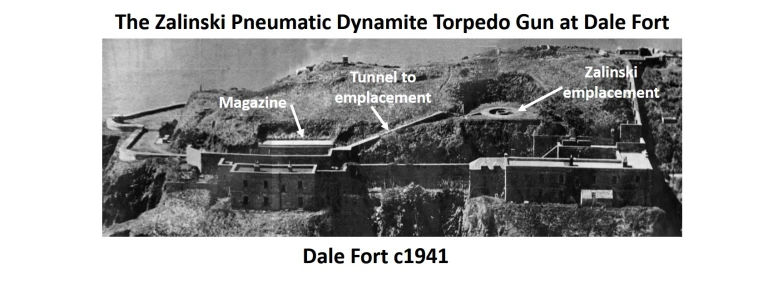
If you look at the photograph above, you can see that the distance between the Zalinski emplacement and edge of the cliff is not great. What can’t be discerned from the photograph is the tunnel between the emplacement and the cliff that leads to the eastern side of the chamber. You might think that all this renders the gun emplacement rather fragile. The gun however pointed over the cliff (at the top of the picture) out to sea. This was where any incoming fire would originate and so it was very well protected by about 25m of rock, which is a lot, even if it is friable. The builders however had now received instructions to attack the cliff from the fragile side. They set about their task with a small digger equipped with a huge steel chisel.
Hacking away at a not all that stable cliff in November 2005
At this point the reader might reasonably be thinking “WHAT THE **%$ WERE THEY THINKING ABOUT???” Hacking away at a friable cliff doesn’t seem a very sensible option when the alternative is to modify the design of the building a bit. I remember the staff meeting where we were informed of what was to happen. My contribution was to outline the problems discussed above (but with more swearing). The Centre Manager, Julian Cremona, knew of course about the chamber and had told the planning meeting that it was probably not a good idea to chop away at the fragile cliff. He had been ignored. I made it my mission to tell the architect (on a rare visit) about the chamber, obviously I was ignored. I think I actually gave a guided tour of the chamber to the Project Manager but it made no difference, although to be fair he was probably only obeying orders (like the SS).
By February 2006, the Office at the top of the cliff, on the end of the Geography Lab (now The Grassholm Room) had been chopped off and they had succeeded in cutting back the cliff by 2m. Retention netting and rock bolts had been installed to ensure stability and perfect safety.
On the 2nd March 2006 sometime between 0630 (when the cook went on duty) and 0700 (when the next person walked by) there was a massive rockfall as the cliff collapsed. The digger was buried under many tons of rubble and very fortunately nobody was injured.
March 2006, a big pile of rubble and a newly extracted digger
The situation was now as follows: Tens of thousands of pounds had been spent, an archaeological site had been desecrated, a useful office with the best view ever had been destroyed and a pleasant lawn had been converted into a hazardous adventure playground.
There followed a hiatus when discussions took place as to what to do next. As Dale Fort Building Project tradition demanded, we staff wondered whether there would be a field centre for much longer. (See Blog Number 83, which explains how the new sewerage system nearly got the place closed a few years earlier, Dale Fort Blog Number 83 | dalefort (wordpress.com))
The Executive Committee of the FSC went back into discussion mode for several months. Eventually, they decided by a narrow margin that Dale Fort was worth keeping. They decided to get the problem fixed and finish the building. This was a great relief to me and (I believe) the other long term staff. It would however, greatly increase the cost of the whole project.
In September and October, a new company arrived. Daredevils carrying huge drills descended the cliff on ropes. They bored very deep holes all over the collapsing face. Eventually, they inserted about 150 rock bolts, each 5m long. They then covered the whole thing with a retention net and sprayed the lot with concrete. It was all very exciting to watch and their efforts made the cliff stable again.
Concrete spraying and rock bolting
Regular readers will remember my mentioning in Blog Number 102 the limestone staircase at the western end of the lawn. CADW (the Welsh ancient monuments people) had stipulated that it was an integral part of the Grade Two Listed Structure and must be preserved at all costs. A key part of the cliff bashing of February 2006 had been to smash it to pieces. This made accessing The Marine Laboratory (now Ramsey) and The Geography Laboratory (now Grassholm) quite challenging. The builders came up with a solution. Their Christmas present for 2006 was some scaffolding stairs and a bridge over the roof of The Research Laboratory (now The Tutor’s Office). This allowed access to the upper levels of The Fort. There remained the problem that mild vertigo sufferers refused to go anywhere near it (including a staff member’s dog, who had to be carried). It soon became known as The Bridge of Doom.
The Bridge of Doom in its final, slightly less doomy manifestation
It was pointed out that visiting staff and students (whose high altitude experience might be limited) would have to use this bridge. The builders put some more poles on it. It seemed more secure and was renamed The Bridge of Despair. It was still quite scary for a lot of our customers and some of our staff. The final amendment was the addition of plastic mesh to fill in some of the gaps. It then became possible to use it without seeing too much of the ground beneath. It had become merely a Slightly Dodgy Bridge and most people found it acceptable. There remained the problem of deterring testosterone enriched students from swinging from the bars, but that’s another story.
Things finally began to get going in January 2007. The drains were laid (completely wrongly as it later turned out) and a concrete base (pumped down a pipe from outside because the cement mixers wouldn’t fit under the entrance arch) put in place.
Laying the concrete floor
By the end of January the block work had begun and by the end of February the ceiling of the ground floor had been installed. The end of March saw the first floor complete and they had finished the second floor and put the roof on by the end of May. As far as I remember, the brickies were by far the most efficient part of the whole thing.
Brick Layers get on with it with unprecedented speed
My over-riding memory of this time is one of dust, delays, mud, delays, mess, delays, mud, more mess and lots and lots of intricate reversing of vehicles, boats and trailers to let delivery lorries and dumper trucks get in and out. Oh, and a lot more mud and mess. Eventually, after 2 painful years, things began to improve.
I think this picture conveys a little of the nightmare
Feverish fitting out of the structure let the first occupants stay in it by the end of August 2007. I was the first to teach in the new building when I ran the last course of 2007 from the (not quite finished) Skomer Room.
August 2007, nearly finished
Christmas 2007 saw the first major event for the new building. Dale Fort was now big enough to host the FSC Annual Staff Conference. It was an extremely successful week. I met someone only last year who still remembered winning the Three Beards Mystery Treasure Hunt event, which I’d enjoyed devising and running. There was a pantomime performed by staff in Dale Village Hall which allowed us (myself and my glorious colleague John Archer Thomson) to lampoon the FSC mercilessly and get away with it. In fact we were lauded for it, not the usual FSC response to satire. There were also lots of flip charts, PowerPoints, SWAT Analyses, and prioritization of our objectives. Who could forget those?
As 2007 turned into 2008 it became clear that the drainage of the building had not been very thoroughly planned. The original intent had been to turf the roof with Sedum (stonecrop). Because of all the problems and delays, this was now deemed too expensive. As a result, when it rained, instead of being absorbed by a bed of Sedum,vast quantities of water poured straight off the bare aluminium roof and a lot of it flowed through the front door of The Ramsey Room. For the last 30 years water had been flooding into the back of the Ramsey Room via the stairs from The Field Stores. Teaching Staff had enjoyed mopping it all up whenever it rained heavily. Julian Cremona had solved this problem in 2005-6 by having underfloor drainage channels cut. Now, just two years on, Teaching Staff were again privileged to mop up floods coming from the opposite direction. The problem was cured by making a concrete ramp at the entrance, to divert the water down the back of the new building. Here it added to the river of run-off that flowed from the roof down the cliff and through the back wall of the main structure, creating a 20m long lake in the void at the back of the building.
This was fixed by cutting an open gully in the floor of the void, the length of the building and connecting it to the newly created drains. It seemed to work reasonably well. However, it does rain rather a lot in West Wales and the next time it did, a new lake formed on the front side of the building flooding the path through the middle of the fort. This made it tricky on rainy days for customers to reach their classrooms and the Dining Room and The Library, or indeed their bedrooms and bathrooms, if trapped on the other side. New builders came and fixed the problem. They did this by digging up the newly laid floor and re-laying the original drains, which had been positioned so they went uphill.
In common with most building projects, a lot went wrong. Like every building project at Dale Fort, a lot more than usual went wrong because of underestimation of the awkwardness of the location; because of supervision of the workers from afar; because of failure to take into account local conditions and I dare say many more problems of which I am unaware. The cost of project had been estimated at £730,000. It ended up costing slightly over £1,000,000 (about 1.7 million today), most of the extra being spent on stopping the cliff from collapsing.

Dale Fort with the St David’s Building in place and fitting in quite nicely
The new building was called The St David’s Building and by 2009 its problems seemed to be mainly solved. It had two rooms specially equipped for use by disabled people, a lift and two excellent new teaching rooms. There were also many more options for student accommodation. The new rooms were all en suite and could hold up to 5 people. They can be used as Air B and B accommodation and are popular with holidaying families at times when Dale Fort isn’t full of students. In 2009, a grassy and decked area on top of the cliff behind The Grassholm Room was made to compensate for the lost lawn.
Don’t miss the next Dale Fort Blog. We are getting dangerously close to the present day with the history stuff. Who knows what horrors might crawl out from under recently settled stones?
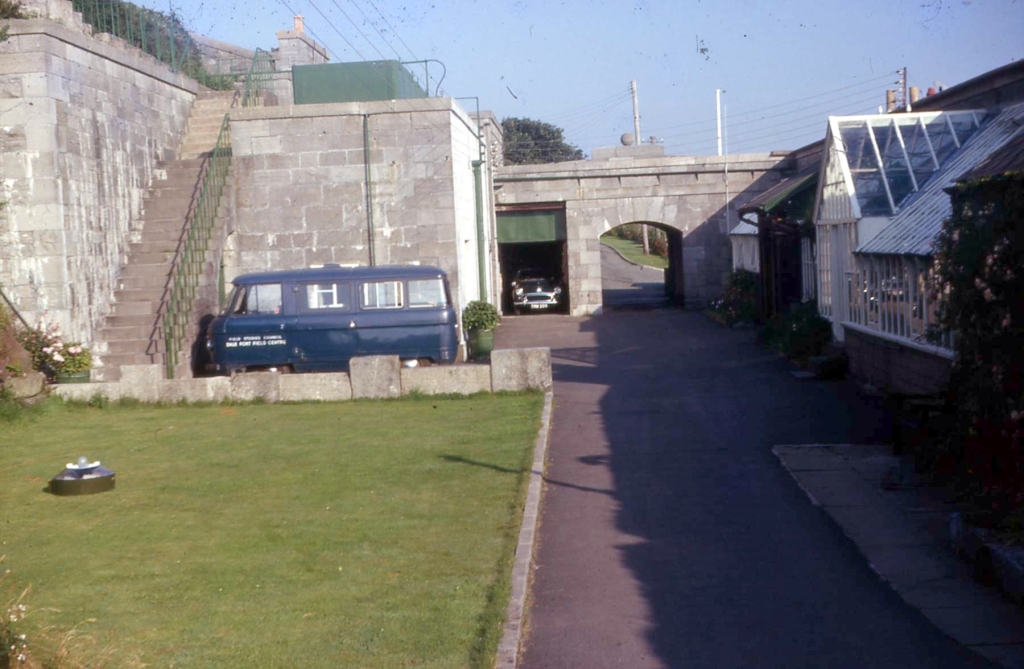
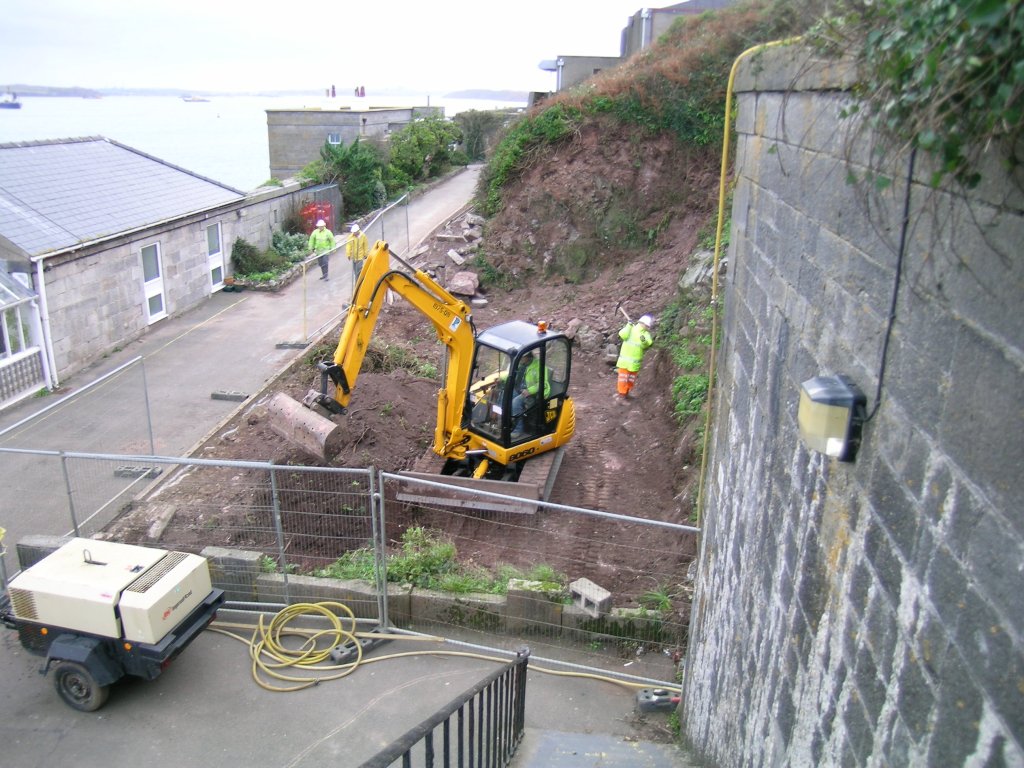




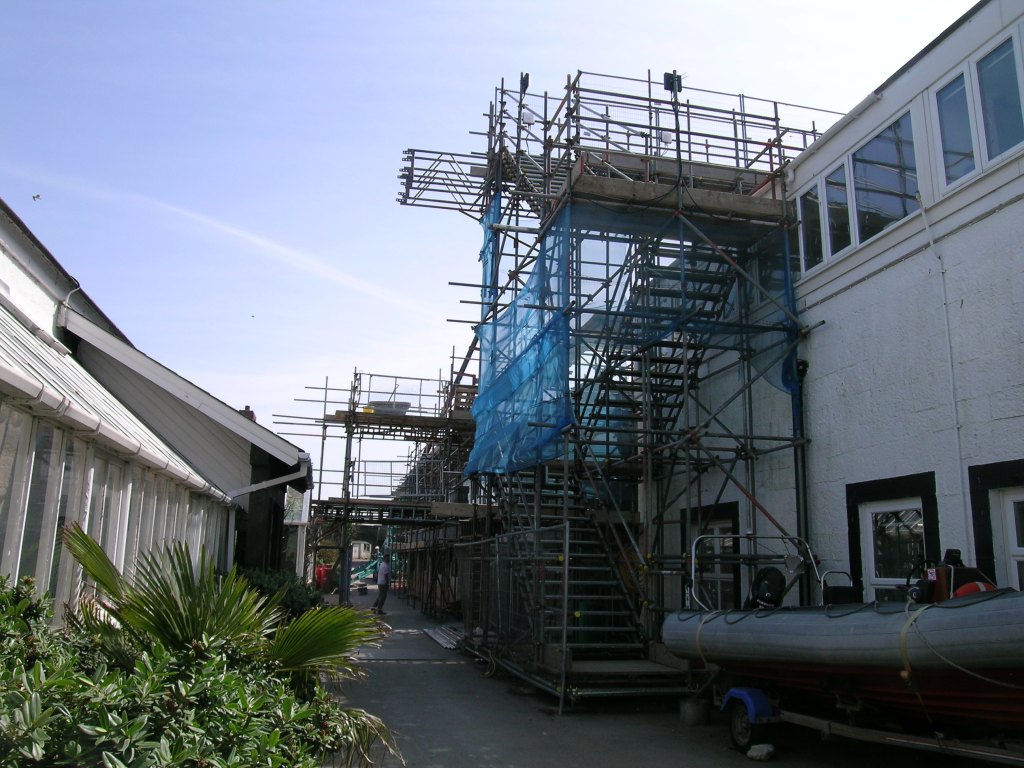
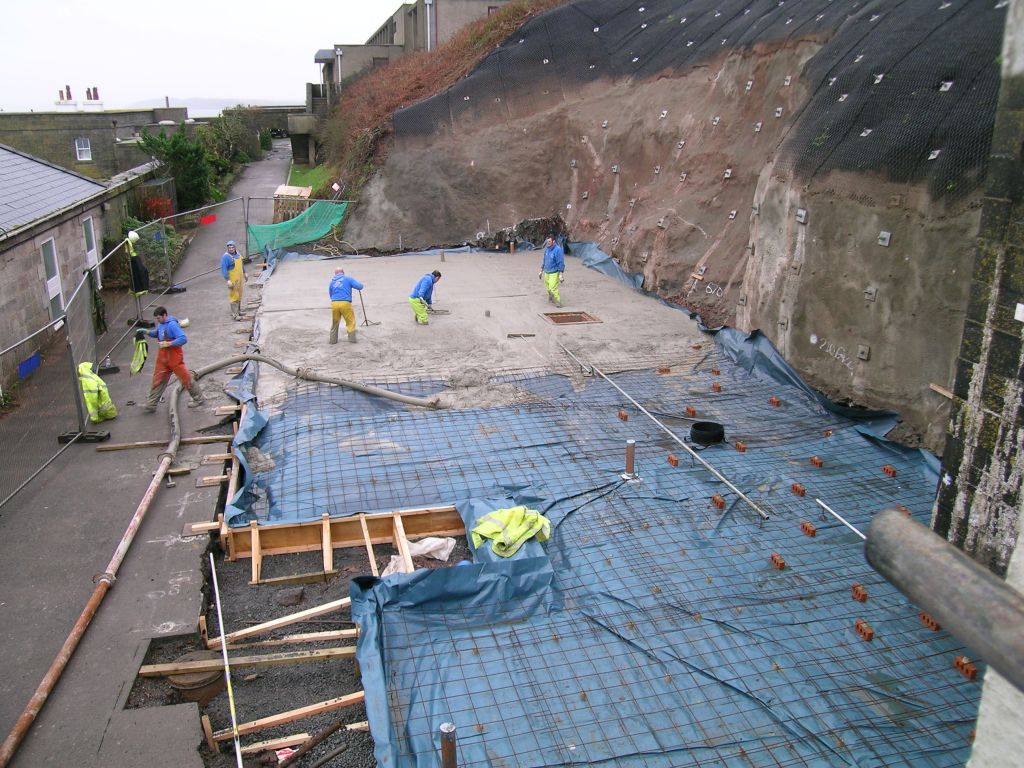
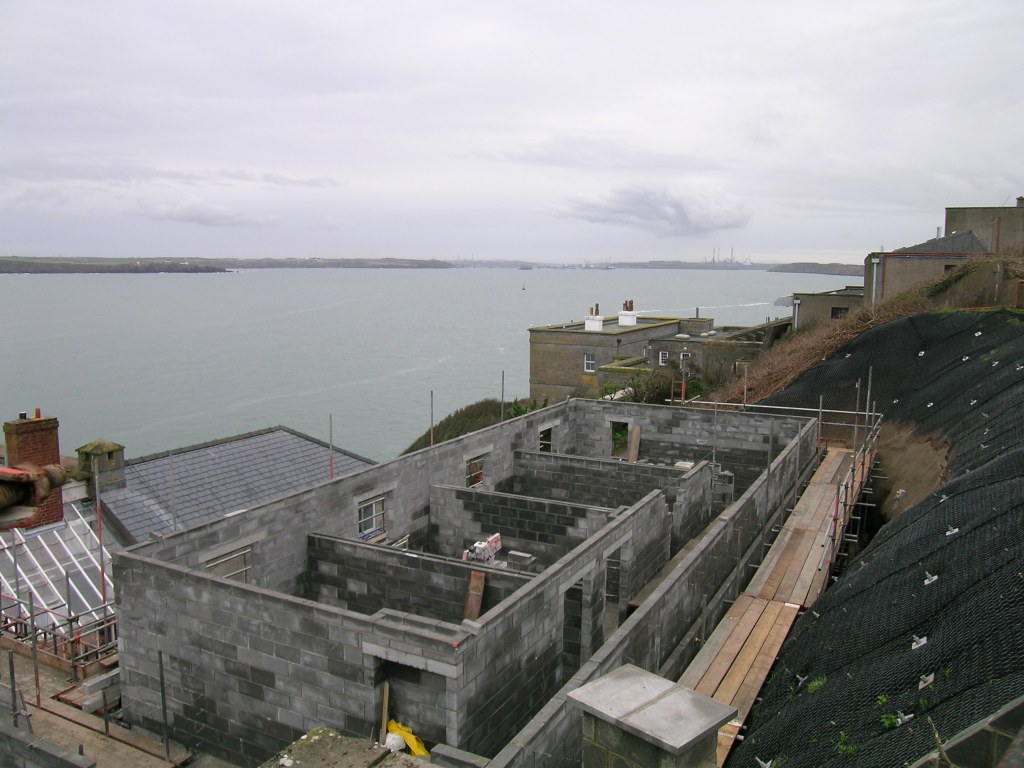

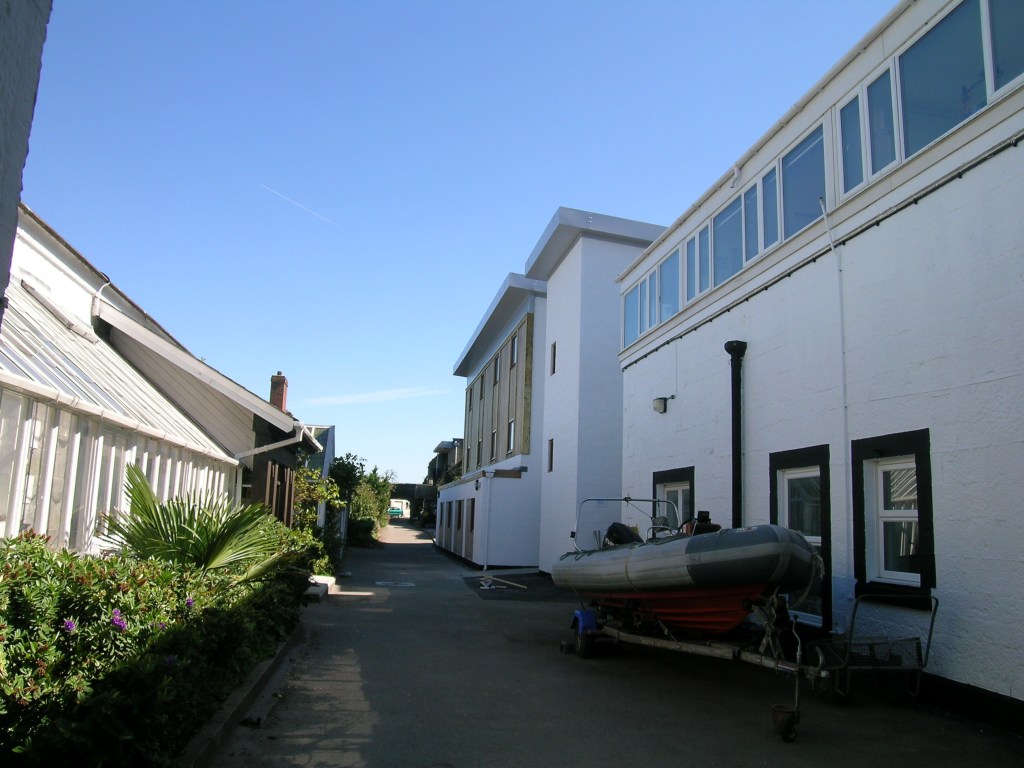
Leave a comment